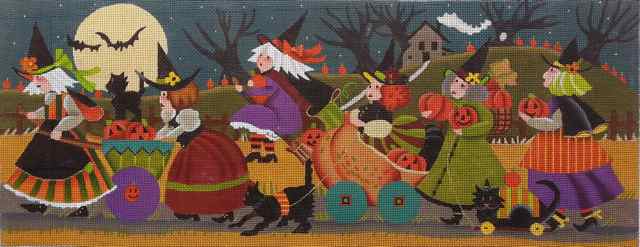The second full moon of the months will rise tomorrow-so celebrate this rare lunar event! Even though this moon is not blue in this canvas, there is quite a large moon in this new Pumpkin March by Melissa Shirley Designs.
What is a Blue Moon?
The modern day definition of a Blue Moon is when there are 2 full moons in one Month. A full moon occurs roughly every 29.5 days and on the rare occasions when the full moon falls at the very beginning of a month there is a good chance a Blue Moon will occur at the end of the month. According to this definition the next blue moon will occur on July 31, 2015, which is tomorrow!
Depending on the exact time of the Blue Moon it is possible that some places in the world don’t technicly have a Blue Moon. As an example the Blue Moon on August 31, 2012 occured exactly at 13:58 UT. The Blue Moon will occur on August 31 for South America, North America, Europe, Africa, Asia, India, and Austrialia but New Zealand will just miss out. For New Zealand the Full Moon occurs just past mid-night on September 1st. For exact times of the Full and Blue Moons see the Full Moon Calendar.
Original Blue Moon Definition
The modern definition of a Blue Moon was derived from an earlier idea of what a Blue Moon was. This earlier definition says a Blue Moon is when there are 4 Full Moons in a season rather than the usual 3. The Blue moon is the 3rd full moon out of the 4. This definition gets a bit complicated and it’s origins are murky. One school of thought has to do with the naming of the full moons. Many cultures named the Full Moons each month to reflected the times for planting, harvesting or seasonal conditions. When an extra full moon was thrown in it was referred to as a Blue Moon to keep the Full Moon names constant throughout the year.
Another origin could be from the Christian ecclesiastical calendar. This one gets even more tricky but basically has to do with the idea that there are usually 12 full moons in a year. The full moons on this calendar were important markers for determining curtain dates such as Easter. When a 13th Full moon was thrown into the year it made things messy so giving it a name allowed the calendar to stay on track.
The idea of a Blue Moon being the extra full moon in a season (or when there were 13 in a year) was widely used in 19th and early 20th center Farmers Almanacs and the more modern version seems to have come from an article written in the 1930’s that misinterpreted the Farmers Almanac definition. The article was names “Once in a Blue Moon” and from that point on the term became part of popular culture.
and until next time…keep on stitching



You are always a font of fun information, Vicky!
thank you! too much time on the computer…